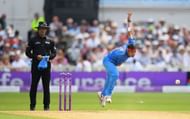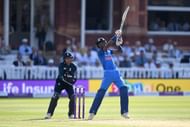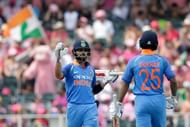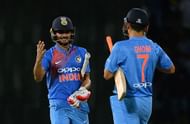
Joe Root's back-to-back tons set up England's emphatic eight-wicket victory over India to give them the three-match One-Day International series 2-1 at Headingley, Leeds. The game was set up by the English bowlers who showcased their skills as a disciplined bowling attack for the second game in a row to keep India in check.
In the chase, Jonny Bairstow gave them a headstart with a cameo before Root combined with skipper Eoin Morgan to shut the door on India with their unbeaten 186-run stand. It was the manner in which both the batsmen were untroubled throughout their innings that hallmarked their remarkable comeback in the series after an embarrassing loss in the first ODI at Trent Bridge.
And it was Adil Rashid who was the pick of the bowlers for the hosts as he outbowled the two Indian tweakers comprehensively. Not only did the Indian spinners manage less spin from the surface, there was never enough pressure built on the batsmen to force them to commit a mistake.
So what went wrong for India after a convincing victory in the first game? Did they get complacent? Did they fail to read conditions and were eventually beaten by a better team? Or was it a case of known issues cropping up once again, leaving the team in troubled waters under pressure. Let's take a look.
#1 Lack of penetration with the new ball

In all the three ODIs against England, the Indian new-ball bowlers sprayed the ball around and gave the hosts a number of boundary balls to be dismissed to the fence. 71/0, 69/0 and 78/2 were what they achieved in the first Power Play and it almost always pushed India on the back foot.
Yes, they missed the service of Jasprit Bumrah with the new ball who has been instrumental in India's success as a limited-overs side but it was a timely reminder to the management to ensure there are enough replacements and backups ready, in case of such freak injuries going into the 2019 World Cup.
The likes of Umesh Yadav, Siddarth Kaul, Shardul Thakur failed to exercise enough control and even Bhuvneshwar Kumar who didn't look fit enough to play the final ODI showed signs of rustiness. For a side which prides itself on fitness standards based on the yo-yo test, the fitness which was reflected in the fielding was appaling, to say the least.
#2 Over-reliance on Kuldeep Yadav

It was no surprise when the left-arm spinner took five wickets in the T20I against England and it was called out to be the sign of things to come. The champion bowler though hit a roadblock in the second T20I and was subsequently dropped from the third. He returned with a bang in the first ODI only to be hit around the park with ease in the next two games.
Joe Root, in particular, seemed to have started to read him much better and England executed their plans against him much better and India seemed to rely too much on him throughout the ODIs. Chahal bowled economical spells but wasn't as threatening as he was when he started and the lack of wickets from the seamers built extra pressure on Kuldeep.
The result was for all to see, many long hops and half-volleys and England ran away with the game with Root anchoring the innings twice in as many games. While it was a good learning curve for Kuldeep, it is a message to the management that you can't always expect a rookie spinner to do the job for you and you need more potency in the bowling department.
#3 No show from Hardik Pandya

A lot has been spoken about the potential of Hardik Pandya but time is running out for him in the 50-overs format to prove his mettle. He has had a forgetful time with the bat and hasn't provided the timely breakthroughs that India expects of him, having been around for more than a couple of years in international cricket.
India's love for him is well documented but against England, he never got going with the bat and was ordinary with the ball. He is the X-factor that India has invested in a lot and more than anyone, Hardik himself will know that he will have to start delivering consistently to repay the faith shown in him.
#4 The over-dependence on the top order

It is always a happy headache to have when you have too many options to select a side but when your top order is this good, it can prove to be a double-edged sword. India have been a very good chasing side in the last two years thanks to the contributions from the top three in Shikhar Dhawan, Rohit Sharma and Virat Kohli.
In most games, one of them has played through to set the game up leaving little to be done by the middle order which seems to be weakening match by match. In the two games that India lost, both Dhawan and Kohli got starts but failed to convert which meant the vulnerable middle order was exposed once again.
It doesn't mean that the top order shouldn't be scoring the bulk of the runs but the team needs to be aware of the over-dependence on them and make sure they have enough confident batsmen in their ranks which can overcome the odd failure from the top order.
#5 The middle order muddle

It keeps cropping up after every ODI series that India plays. The middle order for India is a game of musical chairs with the management stopping the music on purpose, giving more players a chance and therein lies the issue.
The player who is batting at No. 4 is expected to be one who is versatile enough to either set the tempo of the game after a poor start from the top order or one who can make sure there is no let up of the momentum right from the word go.
It is a difficult skill set to master and while India are not wrong to try out players, they have just not given them a good, long run at the position. Coming good in the middle order when you are not even sure how much you have to do, thanks to the in-form top order, makes things more difficult.
Dinesh Karthik got a couple of games before KL Rahul was tried followed by Manish Pandey. Two to three games aren't enough for a batsman to feel his way into the team batting at a vital position. India need to finalize a set of players and give them a good long run at a fixed position which will not only give them security about their place but also help them learn and adapt to the challenges, thereby ensuring their chances of coming good increase all the time.
Follow IPL Auction 2025 Live Updates, News & Biddings at Sportskeeda. Get the fastest updates on Mega-Auction and cricket news
